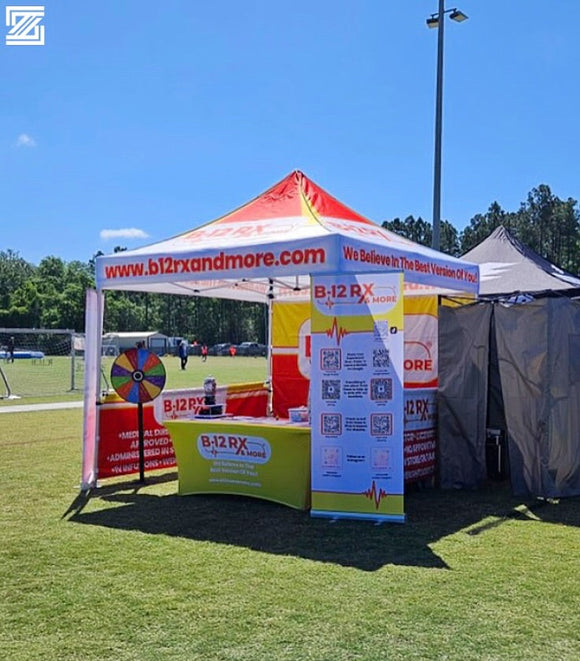
Hoist Your Brand Harnessing the Power of Pole Flags
In advertising and branding, pole flags have emerged as versatile tools to hoist your brand high and capture attention. Harnessing the power of pole flags can significantly elevate your marketing efforts, exceptionally when executed with the expertise of Zulu Marketing and Printing. In this comprehensive guide, we'll delve into the various aspects of pole flags, including types, materials, installation, branding benefits, and more.
Types of Pole Flags
Pole flags come in various types, each tailored to specific needs and environments. Knowing the different kinds can help you pick the best one for your branding and marketing plans. Here are some popular types of pole flags:
1. Custom Pole Flags
These are personalized flags designed to showcase your brand identity, logo, or message. Custom pole flags let you design them in any way you want, so you can make them look special and show off your brand in a unique and cool way.
2. Advertising Pole Flags
Explicitly designed for promotional purposes, advertising pole flags are strategically crafted to attract attention and convey marketing messages effectively. They often feature bold graphics, catchy slogans, and vivid colors to capture the audience's interest.
3. Golf Pole Flags
Golf pole flags serve the dual purpose of branding and course decoration on golf courses. Typically smaller than other pole flags, they display logos or emblems of sponsors, adding a professional touch to golf tournaments and events.
4. Flagpole Flags
These are flags designed to be mounted on flagpoles, commonly seen in public spaces, government buildings, and sports arenas. Flagpole flags can be customized with logos or symbols to represent organizations or affiliations.
5. Event Pole Flags
Ideal for festivals, concerts, trade shows, and outdoor events, event pole flags enhance visibility and create a festive atmosphere. They often feature vibrant designs, event dates, and sponsor logos to maximize exposure.
6. Street Pole Flags
Installed on street poles or lamp posts, street pole flags are used for civic purposes, community events, or municipal branding. They contribute to beautifying urban spaces while conveying important messages to residents and visitors.
7. Feather Flags
Feather flags, also called flutter flags or sail flags, have a special shape that looks like a feather. They are popular for outdoor advertising due to their eye-catching design and ability to sway in the wind, grabbing attention from afar.
Materials Used
The durability, visibility, and overall effectiveness of pole flags depend mainly on the materials used in their construction. Choosing suitable materials ensures that your pole flags withstand outdoor elements while maintaining their vibrant appearance. Here are some common materials used in the manufacturing of pole flags:
1. Polyester Fabric
Polyester is a common pick for flags on poles because it's strong, can handle different weather, and makes colors look really bright and clear. It withstands harsh outdoor conditions such as wind, rain, and sunlight, making it suitable for long-term outdoor use. Polyester fabric is also lightweight, allowing pole flags to flutter gracefully in the breeze, attracting attention.
2. Nylon Fabric
Nylon is another durable and weather-resistant material commonly used for pole flags. It offers excellent color retention and UV resistance, ensuring your flags remain bright and fade-resistant. Nylon flags are lightweight and quick-drying, making them suitable for indoor and outdoor applications.
3. Vinyl
Vinyl is a sturdy and weatherproof material often used for printing graphics and designs on pole flags. Vinyl flags are highly customizable, allowing intricate designs, logos, and branding elements. They are tear-resistant and easy to clean, making them suitable for long-term outdoor use in various weather conditions.
4. Mesh Fabric
Mesh fabric is a lightweight and breathable material commonly used for large pole flags, banners, and signage. It allows wind to pass through, reducing strain on the flagpole and minimizing the risk of damage in windy conditions. Mesh flags are ideal for high-wind areas or locations where airflow is a concern.
5. Canvas
Canvas is a durable and heavyweight fabric for pole flags intended for indoor or mild outdoor use. Canvas flags don't handle weather as well as polyester or nylon ones do. But they have a classic look with texture, which can make any place look fancier. They are commonly used for decorative or ceremonial purposes.
6. PVC (Polyvinyl Chloride)
PVC is a rigid and durable material often used to construct flagpole hardware, such as flagpoles, bases, and connectors. PVC components are lightweight, corrosion-resistant, and easy to assemble, making them a practical choice for mounting and displaying pole flags.
Flagpole Hardware
Properly selecting flagpole hardware is essential for ensuring pole flags' stability, safety, and optimal display. Flagpole hardware includes various components designed to mount, support, and maintain the flags securely. Here are some common types of flagpole hardware:
1. Flagpole
The flagpole serves as the vertical support structure for mounting the pole flag. Flagpoles come in different heights, materials, and configurations, such as aluminum, fiberglass, or steel. They are available in various styles, including telescoping, sectional, and fixed-height poles, to accommodate different installation requirements and preferences.
2. Flagpole Base
The flagpole base provides stability and support for the flagpole, preventing it from tipping over or shifting in strong winds. Bases are available in different designs and materials, including metal, plastic, and concrete. They come in various shapes and sizes to accommodate flagpole diameters and installation surfaces, such as grass, concrete, or pavement.
3. Flagpole Mounting Bracket
The flagpole mounting bracket securely attaches the pole flag. It's usually a metal or plastic clip that goes around the flagpole and keeps the flag steady. Mounting brackets come in different sizes and styles to accommodate flag sizes and pole diameters.
4. Flagpole Cleat
The flagpole cleat is a small hook or cleat mounted on the flagpole used to secure the bottom edge of the flag in place. It helps you easily raise and lower the flag while keeping it tight and properly shown. Cleats are available in different sizes and materials, such as aluminum, stainless steel, or plastic.
5. Flagpole Halyard
The flagpole halyard is like a rope or a cable that's used to pull up and bring down the flag on the flagpole. It runs through a pulley system at the top of the flagpole and is anchored at the base or attached to a cleat for easy operation. Halyards are typically made of durable materials like nylon or polyester to withstand outdoor conditions.
6. Flagpole Ornament
The flagpole ornament, a finial or flagpole topper, is a decorative element mounted at the top of the flagpole. It adds a decorative touch to the flagpole while serving a functional purpose, such as enhancing stability or directing airflow. Flagpole ornaments come in various designs, including eagles, balls, stars, and custom shapes.
Choosing the right flagpole hardware ensures the proper installation, secure attachment, and effective display of pole flags in various settings and conditions. Whether for commercial branding, patriotic display, or decorative purposes, investing in high-quality flagpole hardware is essential for achieving long-lasting and visually appealing results.
Installation Process
Proper installation ensures pole flags' stability, safety, and optimal display. While the specific installation process may vary depending on factors such as flagpole type, location, and mounting surface, the following general steps outline the typical installation process for pole flags:
1. Site Selection
Choose a suitable location for installing the flagpole based on visibility, accessibility, and local regulations. Ensure that the area is clear of obstructions and underground utilities before proceeding.
2. Prepare the Ground
If installing a ground-mounted flagpole, prepare the ground by digging a hole of appropriate depth and diameter according to the manufacturer's specifications. Remove debris, rocks, or roots from the hole to ensure a stable foundation.
3. Set the Flagpole
Place the flagpole in the prepared hole, ensuring it is upright and level. Use a spirit level to verify the flagpole's alignment before proceeding. Add gravel or concrete mix around the flagpole's base to provide additional stability and support.
4. Secure the Flagpole
Once the flagpole is in position, secure it in place using concrete, gravel, or other suitable anchoring materials. Ensure the flagpole is firmly anchored to prevent tipping or movement, especially in windy conditions.
5. Attach the Flag
Depending on the type of flagpole and mounting hardware used, attach the pole flag to the flagpole using mounting brackets, grommets, or other securing mechanisms. Ensure that the flag is securely fastened and positioned correctly to allow for proper display and visibility.
6. Raise the Flag
Use the flagpole halyard to raise the pole flag to the desired height. Adjust the tension on the halyard to keep the flag taut and prevent it from tangling or flapping excessively in the wind. Secure the halyard to a cleat or other fastening device to keep the flag in place.
7. Inspect and Test
Once the flag is raised, heck to make sure everything is safe and working right with the setup. Test the flagpole and flag for stability and visibility from different angles to confirm that it meets your expectations.
8. Final Touches
Make any last changes, like putting decorations on the flagpole or making the area around it look nice. This will make everything look better and more put together.
Size and Shape Variations
Pole flags are available in many sizes and shapes, allowing for tailored branding solutions. Whether you opt for standard rectangular flags or custom shapes, Zulu Marketing and Printing accommodates diverse preferences. This versatility ensures your brand message stands out amidst the crowd.
Branding and Marketing Benefits
The utilization of pole flags offers numerous branding and marketing benefits. Their prominent placement draws attention, effectively increasing brand visibility. Customized designs enable targeted messaging, resonating with your target audience. Zulu Marketing and Printing specializes in crafting custom pole flags that amplify your brand presence and leave a lasting impression.
Maintenance Tips
Proper maintenance is essential for preserving pole flags' appearance, functionality, and longevity. Regular care and upkeep help ensure that your flags remain vibrant and attractive and effectively convey your brand message. Here are some maintenance tips to keep your pole flags in top condition:
1. Regular Cleaning
Schedule routine cleaning sessions to remove dirt, dust, pollen, and other debris accumulating on the flag's surface. Wash the flag with gentle soap and warm water, not too hot or cold. Scrub it softly to clean it without using strong chemicals or rough cleaners that can harm the material.
2. Inspect for Damage
Periodically inspect the pole flag for signs of wear, tear, or damage, such as fraying edges, fading colors, or loose stitching. Fix any broken parts of the flag quickly so they don't get worse and the flag stays strong.
3. Address Stains Promptly
Treat stains or discolorations on the flag immediately to prevent them from becoming permanent. Clean the spot with a wet cloth or sponge using a gentle cleaning liquid. After that, rinse it well with water and let the flag dry in the air.
4. Protect from UV Exposure
Minimize prolonged exposure to direct sunlight, as UV radiation can cause colors to fade and fabric fibers to weaken over time. Consider using UV-resistant fabrics or a protective coating to shield the flag from the sun's harmful rays.
5. Secure Properly
Ensure that the flag is securely attached to the flagpole and properly tensioned to prevent it from becoming tangled, twisted, or entangled in windy conditions. Check the flagpole hardware regularly to ensure that it remains tight and secure.
6. Trim Surrounding Vegetation
Trim nearby trees, shrubs, or vegetation that may come into contact with the flag, as branches or foliage can snag or tear the fabric. Maintain a clear space around the flagpole to prevent obstruction and minimize potential damage.
7. Monitor Weather Conditions
Check the weather forecast and be careful during bad weather like strong winds, heavy rain, or snow. Take down the flag when the weather is really bad to protect it and make it last longer.
8. Store Properly
When you're not using the pole flag, keep it in a clean, dry place where air can circulate well. This helps to stop it from getting damp, growing mold, or getting mildew on it. Avoid folding or creasing the flag unnecessarily, as this can cause permanent wrinkles or creases in the fabric.
Cost Considerations
Investing in pole flags is a cost-effective marketing strategy with significant returns. The initial investment in high-quality materials and design yields long-term brand recognition and customer engagement benefits. Zulu Marketing and Printing offers competitive pricing without compromising quality, making Pole Flags an accessible branding solution for businesses of all sizes.
Conclusion
In conclusion, pole flags offer a potent avenue for branding and marketing, amplified by the expertise of Zulu Marketing and Printing. From custom designs to efficient installation and maintenance, pole flags present endless possibilities for elevating your brand visibility and impact. Use pole flags to make yourself stand out and impress your audience more than others.


